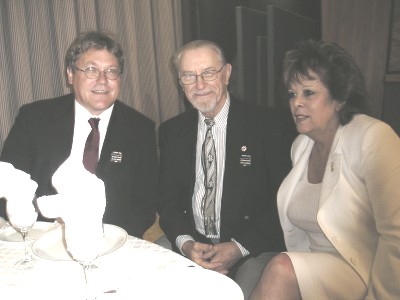
Markus Hess, founder and President, Black Ribbon Day, Algirdas K. Vaiciunas,
former President, Lithuanian Canadian Community, Lithuanian organizer of Black Ribbon Day; and Judi McLeod, former reporter for the Toronto Sun.
Photo: Adu Raudkivi
former President, Lithuanian Canadian Community, Lithuanian organizer of Black Ribbon Day; and Judi McLeod, former reporter for the Toronto Sun.
Photo: Adu Raudkivi
The speeches were first, by Kittask who quoted eloquently from Estonian writer Paul Tammeveski's writings."Why did so many Estonians leave their homeland in 1944. To keep our life, freedom, nationality, language and culture. Did we fulfil our promise. We'd like to believe ... yes ! "
Honourary Estonian Consul General Laas Leivat made a brave statement. "Estonia is the best country in the world. There are no martinet-like dictators or palace overthrows. I ask: how is this democracy supposed to be ? What does it matter!"
The next to speak was Jaak Juhansoo, President of the World Association of Estonian Central Councils from Boston, Massachusetts. He shared a slide show of the first Black Ribbon Day demonstration at Boston.
Ensign Peeter Leppik of the Estonian Army Reserves gave certificates of thanks to those who had help erect a chapel on the Estonian Army base at Tapa, Virumaa. The Estonian Army could not pay for the chapel so the Canadian/Estonian community, headed by all of the community groups and many community members, paid for it.
Finally, Markus Hess, founder and President of Black Ribbon Day spoke in two languages, both Estonian and English about the genesis and growth of a remembrance of the Molotov-Ribbentrop Pact as Black Ribbon Day. The speech was also accompanied by a documentary film.
Present at the event were former Toronto Sun reporter Judi McLeod who, in March, 1990, during the days of Communism, joined Hess, office manager Mr. Bill Guest, and Mr. Jaroslav Sokolyk to fly to Tallinn, Estonia and Vilnius, Lithuania, to meet with independence leaders who they instructed on political action and economic privatization.
Also at this event was Mr. Algirdas K. Vaiciunas, past president of the Lithuanian Canadian Community, organizer for Black Ribbon Day since day one and the person responsible for convincing the Lithuanian Government to name Black Ribbon Day a national day of honour.
Hess started by expressing his plan at the Estonian Central Council's think tank session at Gananoque, Ontario in the fall of 1985. "I remember that meeting," said Kittask, proudly. By the spring of 1986 Hess had acquired the help of David Sommerville of the National Citizens' Coalition (the only right-wing political action organization at the time), Estonian Central Council and the central organizations of all east European societies. "The people met almost every Wednesday, for close to six years to plan and braintrust, to strategize and organize," said Hess.
By August 23, 1986 the first Black Ribbon Day demonstration was held, with 10,000 people gathered at Nathan Phillips Square. The platform was filled with federal, provincial and municipal politicians. Other dignitaries were sitting in front of the platform. Then a line of youth, carrying a long length of barbed wire marched slowly to the platform to the music of a funeral dirge. That was the beginning, five years later the Black Ribbon Days were over and eastern Europe was free from communist rule.
"Black Ribbon Day had been established in 56 cities on 3 continents," said Hess.
Hess explained how Black Ribbon Day organized demonstrations against the Red Army Chorus who they dogged relentlessly from city to city. During the first demo the east bloc demonstrators had circled Massey Hall, in biting cold weather, their constant chant "Shame Shame, Shame" was heard inside, through the walls of the Hall. Tickets were purchased to allow demonstrators entry, so they could disrupt the concert.
As Hess explained, Black Ribbon Day was not just a day of commemoration but a political action movement. When left-leaning politicians started agitating to pull Canada out of NATO, Black Ribbon Day organization opposed them.
When the liberation of eastern Europe came closer, Hess reminded us, the murder of seven Lithuanians by KGB's Black Berets brought Black Ribbon Day demonstrators out in droves to Nathan Phillips Square.
"We had the arches at Nathan Phillips Square renamed "Freedom Arches" and in 1989, the US Congress named August 23 Black Ribbon Day," said Hess.
After the speeches came the folk dances. The dancers were accompanied by a quartet of musicians who also sang. "We started in the early 1970's when we were in university, after trying to get into "Kajakas" for several years," explained one of the dancers. Most were the age of grandparents yet danced with the agility of youth.
The celebrations continued until close to midnight.


















